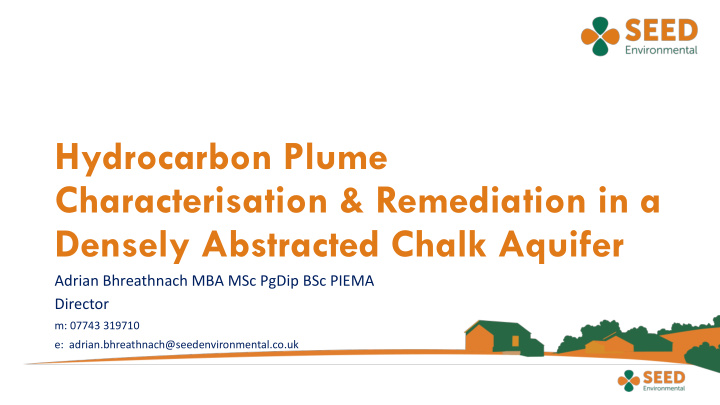



Hydrocarbon Plume Characterisation & Remediation in a Densely Abstracted Chalk Aquifer Adrian Bhreathnach MBA MSc PgDip BSc PIEMA Director m: 07743 319710 e: adrian.bhreathnach@seedenvironmental.co.uk
Telling a Story ry • Background • Objectives • The Challenges • Implementation & Progress • Lessons Learned
BACKGROUND
Background – The Sites • Active Salad Growing • Site A • Glass Area 38,500 m 2 Site A • Two Groundwater Abstractions • >80,000 litre Kerosene Fuel Storage • Site B Site B • Glass Area 13,000 m 2 • One Groundwater Abstractions • >40,000 litre Kerosene Fuel Storage • Glass Area 13,000 m 2 • New Pit Chalk • East Anglia • Groundwater Source Protection Zone 2
Background – The Release • Site B – Pump in Abstraction Well located at 25m bgl - Kerosene • Subsequently – Kerosene identified in Site A Abstraction Well (220m upgradient) • Loss of kerosene heating oil – 4No OST’s - >500 litres / hr usage @ <5 o C • Source of kerosene identified as underground fuel oil delivery line over approximately 6 years
Backg kground - The Source Site A Site B Chilcott. HPA, 2006.
Background - The Receptors
OBJECTIVES
Objectives Stop kerosene LNAPL migration towards identified Stop receptors Reduce dissolved concentrations of speciated Reduce petroleum hydrocarbons to below remedial target levels Remove Remove LNAPL from aquifer
THE CHALLENGES
Overcoming Obstacles & Design (1) The Sites • Business Continuity • Glass Houses • Groundwater >20m bgl The Regulations • Environmental Permit Regulations & Position Statement 3A • Water Resources Act 1991 • Zero Capacity The Discharge • No Foul Sewer within 1km • No Surface Water • Contaminated Chalk Aquifer
Overcoming Obstacles & Design (2) Data Inconsistencies • Consultant Well Sampling – Inconsistent Results & Trends • Historical water table levels Contaminant Transport Routes • Fracture Flow • Migration Flux Rate (750,000 litres / day) • Migration Depths (~22m & ~24m bgl)
IM IMPLEMENTATION & PROGRESS
Remediation Stages • Plume Management (Groundwater) 480,000 litres / day 854,000 litres / day • Low-Flow Fracture Plume Containment Stage 1 • Source Management (Soils) • Excavation & Soil Vapour Extraction Stage 2 • Active Removal – Free Oil & Dissolved Phase • Targeted Flow Abstraction & Optimisation Stage 3 • Enhanced Biodegradation (O 2 Injection) • Natural Attenuation Stage 4
Key Free Phase Plume (2017) 67,000m2 Key Free Phase Plume (2018) 25,000m2 LNAPL Area LNAPL Area 2017 2018
Dissolved Phase Contamination Plume (2017) Key >100 µg/l >1,000 µg/l >10,000 µg/l >100,000 µg/l
Dissolved Phase Contamination Plume (2018) Key >100 µg/l >1,000 µg/l >10,000 µg/l >100,000 µg/l
Progress & Next Steps Site A • LNAPL removed – Awaiting rebound assessment Site A • Stage 4 – Enhanced O2 biodegradation ongoing Site B • >99.9% Reduction in dissolved hydrocarbon concentrations Site B • LNAPL recovery ongoing • Delays due to reinjection limitations now resolved • Implementing system amendments on western boundary to increase LNAPL recovery area and rates
Lessons Learned
Take Forward Messages • Timely regulator engagement and enforcement flexibility is critical to effective pollution control. • Critical project data informing decision making needs to be consistent, reliable and that any ‘irregularities’ need to be understood prior to remediation design. • Innovative site characterization techniques can also be deployed during remediation to provide effective low- flow and targeted groundwater treatment solutions in Chalk aquifers. • A great example of the time and financial benefits of prioritising conceptual understanding, effective characterization and remediation design.
Recommend
More recommend